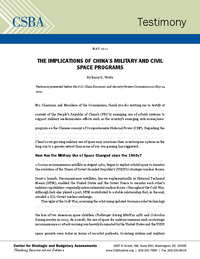
Mr. Chairman and Members of the Commission, thank you for inviting me to testify at today’s hearing. I will confine my comments to the Commission’s questions on the overall context of the People’s Republic of China’s (PRC’s) emerging use of orbital systems to support military modernization efforts such as the country’s emerging anti-access/area denial (A2/AD) capabilities in the western Pacific, including the impact of the PRC’s space program on the Chinese concept of Comprehensive National Power (CNP). Regarding the role that the PRC’s space assets might play in U.S.-China conflict scenarios in the 2012-2020 timeframe, I will assess the likelihood of such conflicts occurring and argue that China’s own growing military use of space may constrain their counterspace options in the long run to a greater extent than some of our war gaming has suggested.
How Has the Military Use of Space Changed since the 1960s?
The United States, starting with the first successful return of a film canister from a KH-1 Corona reconnaissance satellite in August 1960, began to exploit orbital space to monitor the evolution of the Union of Soviet Socialist Republic’s (USSR’s) strategic-nuclear forces.
The USSR followed suit in April 1962 with the first successful return of film from the third Zenit-2 launch. Reconnaissance satellites, known euphemistically as National Technical Means (NTM), enabled the United States and the Soviet Union to monitor each other’s military capabilities—especially intercontinental nuclear forces—throughout the Cold War.
Although luck also played a part, NTM contributed to a stable relationship that, in the end, avoided a U.S.-Soviet nuclear exchange.
Throughout the Cold War, accessing the orbit using updated German rocket technology was costly, technically difficult and failure-prone. Excluding Corona launches without a camera, the initial KH-1 success was preceded by eight missions failures. Recall, also, the loss of two American space shuttles: Challenger during liftoff in 1986 and Columbia during reentry in 2003. As a result, the use of space for military missions such as strategic reconnaissance or attack warning was heavily dominated by the United States and the USSR well into the 1980s. Indeed, American and Russian quantitative dominance of near-Earth space persists even today in terms of on-orbit payloads.



























